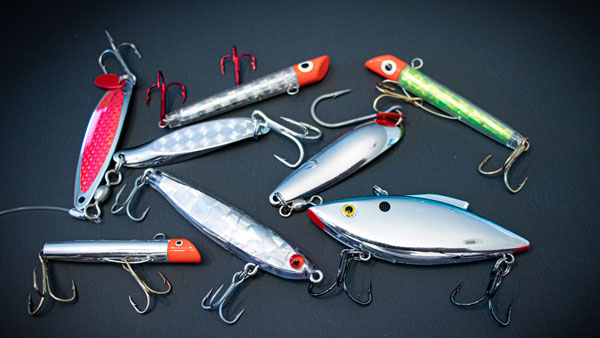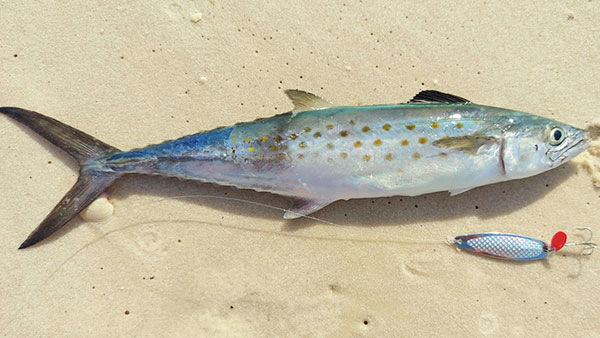 |
Spanish Mackerel just might provide surf anglers the most action of any targeted game species. When it comes to surf fishing, it's oftentimes a sedentary game, with anglers sometimes putting in hours of rod watching for each fish in the cooler. Surf fishing for Spanish Mackerel allows anglers their best chance to flip the script, and put more fish on the table than ever. Once the water warms in the Northern Gulf these fish will literally swarm the surf in the hundreds or even in the thousands, ravenously feeding on virtually anything in their path. Spoons, lures, live bait, artificials, and just about anything shiny can provide awesome fun for adults and children alike.
About Spanish Mackerel
Spanish Mackerel are plentiful, perpetually hungry, and among the fastest fish that swim. These traits, and the fact that they travel in huge schools give surf anglers an opportunity at non-stop action that few other gamefish can provide. Spanish Mackerel, or just "Spanish" as most anglers here in the Pensacola area call them, have long, slender, and muscular bodies that can propel them at breakneck speeds through the surf, oftentimes being seen breaking the surface while chasing baitfish during late spring and throughout the summer months.
Spanish Mackerel are a migratory gamefish and spend much of their time traveling in huge schools searching for water temperatures that best suit them, as well as areas that hold large amounts of baitfish. Their diet consists primarily of other fish, although they do consume shrimp and squid as well. In late spring and summer, the stock of fish within the Gulf of Mexico travel north seeking cooler waters, and in the fall and winter these same fish will return south in pursuit of the warmer waters in and around the Florida Keys.
Spanish Mackerel are not a large species, with fish in the 20-25 inch range being considered a "stud spanish". A fish this size will have a considerable amount of muscle mass and is just about the perfect length for consumption. This is just a general guideline, and fish shorter and longer than this are still absolutely excellent table-fare. Most fish will reach about 12-14" in their first year, but their growth slows after that. Females grow larger than males, and can reach lengths of around 30" inches or slightly longer, although this is somewhat rare. Males will generally reach about 20" in length.
When To Fish For Spanish Mackerel
Spanish Mackerel are a migratory species, and they will generally arrive in the Pensacola and Destin area around the end of May or early June when water temperatures reach about 80 degrees. They will become more abundant and more active as water temperatures increase into the mid to high 80's, and eventually start to thin out when surface temperatures begin to drop, triggering them to head south once again, usually around late September. In general, surf fishing for Spanish Mackerel throughout the entire summer is usually good to excellent along the Florida Panhandle as well as the rest of the Northern Gulf Coast.
One of the best times to surf fish for Spanish Mackerel is early in the morning when there is a slight offshore wind (wind from the North, in the Florida Panhandle). This calms the surf significantly and will enable you to see baitfish boiling on the surface much easier, a good sign that Spanish Mackerel are feeding below. Casting a lure or spoon directly behind the boil and retrieving through the baitfish is an excellent way to catch fish. Walking, or sometimes even running along the beach chasing these fast moving fish provides hours of entertainment when the conditions are right.
Gearing Up For Catching Spanish
In terms of specialty fishing equipment, Spanish Mackerel do not require much. There are really only a few things "special" about fishing for Spanish:
- They have razor sharp teeth. Steel or heavy monofilament / fluorocarbon leaders are an absolute must. In general, we prefer and use mono leaders made of anywhere between 50 to 100 pound test. This is entirely personal preference, and a short steel leader of around 10-20 pound test will work well. You do NOT need a premium leader, just something durable.
- You need a hook removal tool. This can be a dedicated hook remover, forceps, or needle nose pliers, but you have to have something. This helps protect both you and the fish. As we've mentioned, their teeth are absolute razors, and they aren't afraid to use them. Having these tools also helps eliminate fish being cut off / released with hooks in their gullets.
- It helps to have a longer rod. When the Spanish are a little further out, it really helps to have a longer surf rod in order to get your lures to them. You still don't need heavy equipment, but a longer rod will give you the distance you need. When we're on the beach looking for Spanish, we usually have a medium action 9' rod spooled up with light weight braid to give us the distance we want. At the end of the day, however, you shouldn't worry about going out with your favorite Ugly Stick. If the fish are around and in range, it will do just fine! Just keep in mind you had best have a heavy leader tied on!
- They like fast moving baits. Being one of the fastest fish that swim, Spanish Mackerel are attracted to fast moving lures. A reel with a fast retrieval rate helps move your lures quicker, and can make the day a little easier on your wrist. That being said, don't be afraid to head out and have some fun with what you have.
Best Lures For Spanish Mackerel
Spanish Mackerel feed primarily on other fish so using lures that mimic their prey are the most effective. Fast moving spoons and hard baits are most commonly used when targeting Spanish from the surf. Streamlined lures that can be cast a significant distance will increase the amount of water you can cover and will increase your chances at hooking up.
 |
Spoons
If there was a single classic spoon for catching Spanish Mackerel it would probably be the Johnson Silver Minnow. This spoon has probably put more Spanish in the cooler than any other lure out there. These days it faces stiff competition from other spoons such as Kastmasters, Krocodiles and Sea Strikers, but it is still a staple for many anglers. Brand specifics aside, most anglers choose to use spoons in the 3/4 to 1 1/2 ounce range. Since casting spoons are rather heavy for their size / profile, this allows long casts through the wind while still keeping the lures profile on the smaller side. When it comes to the spoon's main color, silver is the hands down favorite. We personally favor spoons with prism type finishes, but plain-old silver spoons still provide plenty of fish attracting flash. Anglers sometimes replace the treble hooks on spoons with a larger single hook for better penetration but this is personal preference.
 |
Hard Baits
It would be a crime to not mention Got-Cha lures while talking about Spanish Mackerel. These have produced an absolute mountain of Spanish, and we would be remiss not to mention them specifically. They cast a mile, have built in rattles, and can be reeled in at high speeds which is perfect for targeting these speed demons. In terms of other hard-baits, honorable mention goes to Rat-L-Traps and MirrOlure MirrOdines. Many other baits will work exceptionally well provided they cast far and handle a quick retrieve.
Once again, silver or chrome colors are best here. We're trying to imitate baitfish and most of them are silver. Overcast days can call for adding some charteuse, red, or pink into the mix but until you're confident it's best to just stick with silver and chrome, with small amounts of blue or black mixed in.
Best Set-Rigs For Catching Spanish Mackerel
Some spoon loving die-hards may thrash us on this one, but it is entirely possible to catch Spanish Mackerel on stationary rigs. Yes - we've been talking about fast moving lures this entire time, and that is the traditional way to catch Spanish Mackerel, which has been proven time and again. The truth is, just like every other creature that survives in the wild, it is hard for them to pass up an easy meal.
When it comes down to it, Spanish can be caught with live and dead bait alike. Many Pompano fishermen can probably attest to being bitten off by several species, Spanish Mackerel included. The trick to catching Spanish Mackerel on set rigs is to upsize your leader significantly and use baits similar to what they would traditionally be chasing (think "fishy"). We do not advise switching to a metal leader material in this case, but utilizing heavy monofilament since it will not cause your presentation to sink, and because it will be slightly less visible. Even though Spanish Mackerel are not line shy, a stationary bait will allow them to take a better glimpse at the entire rig, and we want to have every advantage we can get.
When targeting Spanish on a set rig, we typically use a double dropper type rig, which is basically what a Pompano rig is. We tie them up with 60lb Berkley Big Game, or even higher test. We use a Surgeon's Loop knot instead of a dropper loop, since it is easier to tie, and stronger. The same 2/0 hooks Pompano anglers know and love work well, we just need the heavier test line to deal with the teeth in this case.
As with Pompano rigs, floats are optional, but the real deciding difference here is that we will use pieces of fish, or small live bait to tip the hook instead of shrimp or sand fleas. Some of the most available and effective bait we have found is small strips of previously caught Ladyfish or Blue Runners (hard tails).
Fishing for Spanish Mackerel in this way is definitely the lazy approach, but it has consistently produced fish if the schools are passing through our rigs. The only downside to using this technique is that it doesn't normally produce much else.
Spanish Mackerel are probably one of the first fish young anglers "graduate into" after targeting smaller species such as whiting. They can be pursued more actively than most, and are a great way to hook, or keep young anglers hooked on the sport of Surf Fishing and they are an absolutely spectacular table-fish to boot.
In our opinion, they are quite possibly the most under-rated fish we see here on the northern gulf coast, and we do our best to promote their pursuit. Hopefully you find them as profound a quarry as we do!